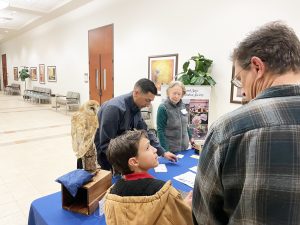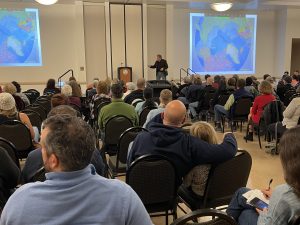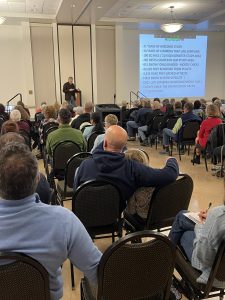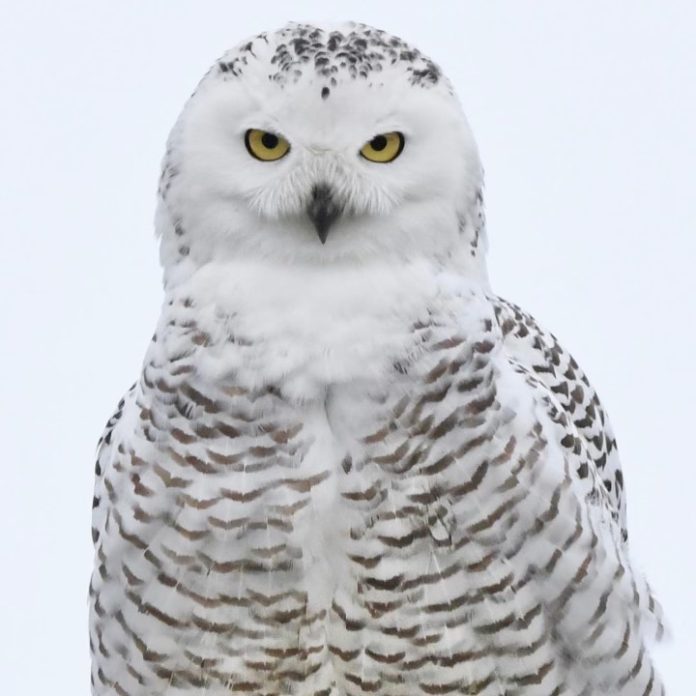Snowy, the majestic white owl who mystically and mysteriously landed in Cypress, is apparently headed back to the Arctic this week, but not before exciting the community and leaving the footprint of a feathery legacy.
With the aid of the Sea and Sage chapter of the Audubon Society and the California Department of Fish and Wildlife, wildlife expert Denver Holt took the stage to present a program entitled “The Breeding Ecology of Snowy Owls.
Gail Richards, Sea and Sage Audubon Society President, thanked the Cypress Recreation Department for donating the use of the Community Center for the event.
Just a day or so before Denver Holt, a wildlife expert and founder of the Owl Research Institute was scheduled to speak at the Cypress Community Center, the great white bird apparently, just as quietly, and mysteriously, flew away.
“If she’s not gone, we do not know where to find her,” said Roy Raush, a Cypress birding enthusiast that became the ad-hoc citizen coordinator, monitoring the bird’s daily whereabouts and letting the public know where to find Snowy.
He started a Facebook page that already has more than 2,000 members and kept the interested gaggle supplied with data throughout the unfolding saga.
Scott Thomas, a raptor biologist, thanked the community for its humane treatment of the Snowy Owl. Thomas said he had been out to see the large bird.

Carson and Kaden Hansen are thrilled with stuffed owls as they arrive with their dad Tom.
“I went to check out how you were doing,” said Thomas, “and you (the community) were doing great.”
Thomas remarked that even when he visited the site, the questions about “migration,” and “protecting the birds,” indicated the huge amount of interest that was even more evident with the large crowd.
And it seems that the interest in wildlife and birding that the owl sighting ignited was significant, with 300-400 people attending in the Community Center and another 500-700 people watching online.
Melissa Borde an environmental researcher at the Bolsa Chica reserve, reminded the nature lovers in the audience that the 1,300-acre Bolsa Chica reserve was just a few minutes away if they wanted to retain their birding interest.
“This American encounter has clearly inspired curiosity amongst thousands of community members,” said Borde, “it’s pretty incredible.”
Borde, who introduced Holt, said he is the founder and president of the Owl Research Institute in Charlo, Montana. “He believes field studies are our primary means to understanding trends and wildlife population.

DNYphoto
Holt “has been a leader in our research, education and conservation for more than 30 years,” she said, suggesting that Holt is perhaps one of America’s leading authorities on owls.
“Of all the animals in the world,” said Holt, “owls are among the most recognized groups in the world.” He said owl populations exist on every continent except Antarctica. Owls have existed in native cultures for thousands of years, he said.
“Owls are in native cultures as far back as we can go,” he said. “There’s etchings on cave walls in France that date back 15 to 30,000 years,” said Holt. Owls are just so widely recognized everywhere they go, but of all owls, the Snowy Owl is, by far, the most famous in the owl family, he added.
Holt said he was “fascinated” with the turnout of owl interest in Cypress, yet said it was understandable, given that public furors like the one that erupted in Cypress seem to occur every time and place a Snowy Owl shows up.
“It’s pretty spectacular,” said Holt, saying people just don’t go out to see a lizard or a bear, but crowds like the one in Cypress happen every time for Snowy Owls.

DNYphoto
“This happens anywhere in the country when ‘the Great White Bird of the North,’” as Holt referred to it, shows up in a city south of the Arctic Circle. “For whatever reason, there is a public fascination with the Snowy Owl like no other animal,” he said.
Cypress was no different. With each sighting of the Snowy Owl, a long line of onlookers, photographers, birdwatchers, and gawkers assembled, yet always in an orderly fashion to catch a glimpse of the big white bird.
Many were anxious to hear about how in the world the bird picked Cypress to land in and one young lady was concerned the bird might not be able to get back home.
“It is unusual how far south it is,” said Holt in referring to the Snowy Owl in Cypress. “But normally, they, Snowy Owls, are programmed to migrate,” he said, “so when they migrate, they usually end up in southern Canada. My guess is this one simply overshot.”
“This one is pretty far south,” he acknowledged.
Holt presented color images of his research work, giving participants an up-close look at these animals. The Snowy Owl is recognized globally as the ‘The Great White Owl’ in recognition of the bird’s sheer majesty, said Holt.
Using his folksy Montana drawl, an animated Holt took in attendance through the breeding ecology of the Snowy Owl, drifting from side to side of the large room. The male Snowy Owl, he said, is pure white (“they glow,” said Holt).
The large owls are most comfortable on the Arctic tundra, he said. When they breed, Holt says the female guards the nest while the male generally gathers food, mostly consisting of plentiful lemmings (rodents).
During winter, the birds migrate south for food. He said the great white raptors can travel as far as 40 miles per day.
Mostly, he said, Snowy Owls will end up in southern Canada or the northern U.S., but Snowy Owls have been seen in states like Texas and Florida. “A few years back, one ended up in Hawaii,” said Holt.
Like on cue, the Cypress Snowy Owl left a day or two before Holt arrived. Nevertheless, he said photos of that bird indicated to him that it was a female, approximately eight or nine months old, participating in her first migration.
Holt termed the event an “irruption,” meaning when migration events push birds southward in years of low food availability. Based on the scientific evidence, the Cypress Snowy Owl must have had a field day in Cypress, staying fed pretty well, loading up on rodents from the military base and the Los Al Racecourse during her extended stay.
Holt said prior experiences like the one in Cypress indicate that when a Snowy Owl shows up, people do the flocking as the great white owls always attract a crowd.
“It’s almost like a sporting event,” he said.
For one young family in Cypress, that is exactly what happened. A 12-year-old bird watcher’s mom would not even let him change clothes when she heard there was a Snowy Owl in Cypress.
Kara Blomberg said when she heard the Snowy Owl was here, “we dropped everything.”
“I have five kids, and they were in their pajamas,” she said, “and I ran upstairs. I said ‘Jace (her son) don’t even change, we’re going to see a snowy owl.’ And we went at like eight o’clock in the morning. It was wonderful,” said Blomberg.
“I came tonight (to the presentation) because when I saw this was happening tonight, I am trying everything I can to foster their interest. I love gleaning from people who know more than I when my kids’ interests are at stake,” the young mom said.
Zeke Cooley, a biologist, and his girlfriend Amy Walters, who works on environmental issues, said they attended the Cypress Community Center event because “We just can’t stay away from it. We’re both amazed by wildlife,” said Cooley. The Snowy Owl is just such a majestic creature that it just stands out,” he added.
“We think it’s really great to be a part of this, especially since everyone in the next generation was exposed to wildlife and the sciences. It was cool that this animal came so close for everyone to see,” said Walters.
“This was a great start to the new year,” said Cypress Mayor Anne Hertz-Mallari, who attended the event with Council member Frances Marquez.
“We’re just glad to see such a great turnout from the community. We appreciate the passion,” she said.
Marquez said she had followed the event closely since the beginning since the first sighting of the Snowy Owl occurred near her home. “This has been a wonderful event for Cypress,” she said.
Holt said he sensed a deep connection to the owl in the Cypress community. He again emphasized that it is not uncommon for the connections between the community and the Snowy Owl “people are fascinated, thrilled, there’s just so many connections it feels spiritual.”
By now, Snowy the Owl is likely winging her way back to the Arctic tundra, but according to Holt, there is a better-than-even chance the Snowy Owl could return.
“She’s programmed to go back,” Holt reassured one young resident, who was worried that the poor owl might be able to find her way home. “She could take the same route to get home as she came here,” he said.
Holt said there are any number of potential routes the Snowy Owl could have taken to get here, even through Russia, but he thinks the young owl flew straight down the Pacific Coast.
But now that the route is programmed in her brain, Snowy could indeed return, said Holt.
“Some of them come back year after year,’ he said, adding “there is good data to indicate some of those birds come back,” even if it could take years.
“When you catch a glimpse one year, you might not see that bird again for 10, 15 or 20 years,” said Holt, but “that does occur, and she is certainly capable of doing it.”

